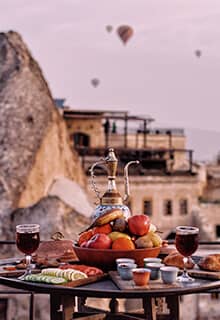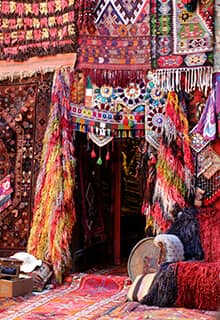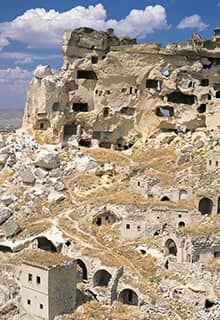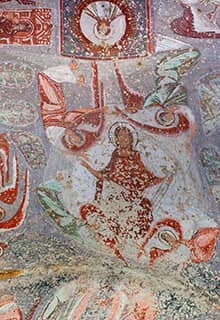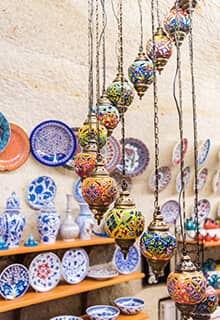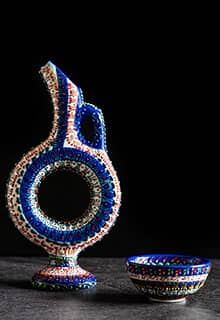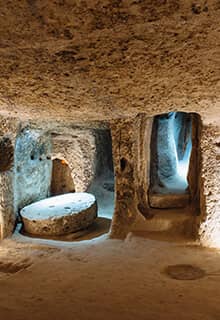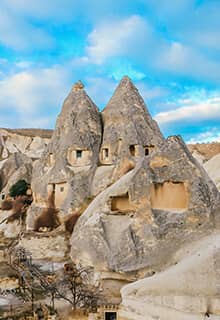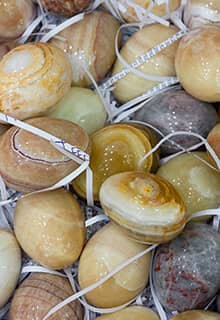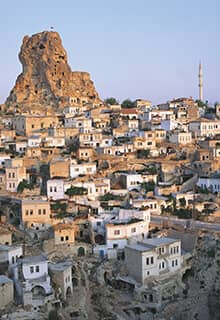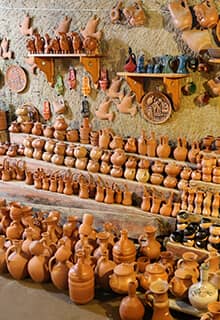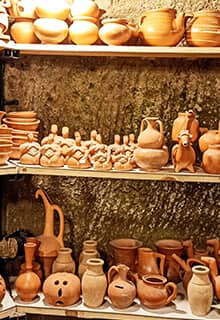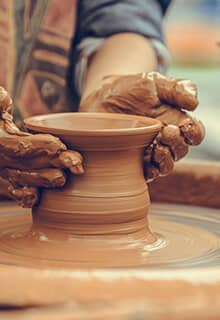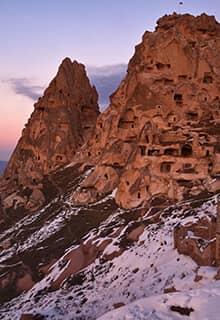

touch
Cappadocia
Cappadocia is home to hand made silk and wool carpets. To sense the opulence in these textures is truly an experience onto itself. One can even witness the miraculous process of silk threads production. The cocoon of the silkworm is delicately unwrapped to present one with the miraculous fiber that is silk. The local silk ateliers produce a dizzying variety of products from this beautiful and rare fabric, ranging from scarfs to even carpets. Come indulge yourself in the decadence of luxury.
Cappadocia is also home to varied handcrafts. You can even make your own clay pot here. One is drowned by choices of wares from ornamental trinkets to kitchen and table wares. Some clay ateliers pride themselves for their artistry of elegantly painting and embellishing custom clay and ceramic wares. A perfect memento for the fabulous memories of Cappadocia.
Pottery
Located 18km from Nevşehir city, Avanos is famous for its tradition of pottery-making that has been alive since the times of the Hittites. If you want to give it a try, call in at a workshop, and take up your position before the wheel. What happens next is up to the skills of your hands and the vividness of your imagination. Master potters standing nearby will lend you their support and maybe give you a few pointers.
When you leave, do not forget to pick up an example or two of the craftsmen's work as a memento of your time there.
Carpets & Kilims
Although the flatweave technique used to create rugs has been cultivated in many locations around the world, most of those practices originate in Central and Western Asia. A great number of nomadic Turkic tribes passed through Anatolia, leaving elements of cultural heritage and know-how behind, but the tradition of textile weaving might be the one that directly takes us on a journey through time.
Traditional nomadic homes didn’t have furniture, which is cumbersome. Instead, the tent-dwellers would rest on carpet-covered floors against floor cushions and rolls of bedding. These textiles were meant to be practical as well as beautiful. In winter, the rugs were used to cover indoor spaces and insulate against the cold. In the summer, they could act as shade and protection from the heat. Kilims and fabrics were also a major part of wealth exchange, so weaving was usually an important skill for a woman to have – used as leisure activity rather than a full-time occupation.
There are two main types of rugs currently in production in various locations around central Anatolia. First, there is the kilim (a flat-woven carpet), the oldest of which is thought to have emerged in Çatalhöyük near Konya in 7,000 BCE. The second type, halı (knotted rug), is believed to have been introduced by Turkic tribes sometime during the 8th or 9th century, and to have made their way to Anatolia during the 12th century. While kilims were used to make travel bags and floor cushions, halı, rugswere used to cover the walls and floors of stone houses, making them cozier, and more importantly – warmer.
Between the 12th and 19th centuries, village women wove carpets for private use, turning them into forms of self-expression. Working with their hands, they used exotic natural materials like wool and silk, while design reflected symbols and motifs symbolizing their tribal heritage, hopes and dreams, as well as local superstitions. Today, handmade carpets remain in Turkish culture as an art form.
Production of a Turkish Carpet
Silk is what makes the Anatolian region of Kayseri stand out amongst other locations known for rug production. This precious thread is used to make the most exclusive rugs, the purchase of which is considered a serious investment. The long and complicated silk carpet weaving process starts with washing raw silk, delicately unwound from its cocoon, in hot soapy water.
Once the thread is rinsed, the dye is added to the water. Color is a very important element of any carpet or kilim, often used to determine the origin of a particular item. While today chemical dyes are often used, in the past, the threads were coloured entirely with dyes obtained from roots of various local plants. The recipes are tradesman’s secrets. Therefore, use of the same material by different dyers result in varying color tones, which are also affected by other factors such as soil type or local microclimate.
Dyed thread is divided according to their colour palette and left to dry. Once the threads are ready, they are loaded into looms, and warped according to the desired dimensions of the carpet. Based on the thread’s thickness, the weaving process might take anywhere from six months – for a small 30x40cm decorative pieces – to several years for carpets larger than two square meters.
As silk threads are smooth and shiny, pure silk carpets woven on the weft (horizontal weave) using silk, cause an optical illusion of changing colours when rotated 180 degrees. The same pattern seen from different angles seems different. If the vertical threads (the warp) are thicker than the horizontal ones, it means two different materials have been used to make the carpet’s frame. A pure silk carpet is not only very thin but also very smooth, so you can easily slide and spin it on the floor (hence the majority of them are not meant to be walked on, but rather hung on walls or displayed in frames like paintings), while blends tend to be more spin-resistant. Thick, soft thread denote cotton, thick and itchy ones are pure wool.
Hot Air Balloons
As dawn breaks, you will float in air with great calmness… Rock formations dating back millions of years, unimaginable landforms unique to this geography lying beneath. Valleys offering majestic sceneries, high altitudes painting a multi-hued topography down below, slopes weaved in velvety texture… The land of fairy chimneys has become the center for hot air ballooning gradually over the past 20 years and the intoxicating morning cruises have been attracting more and more travelers from all over the world with each passing day. The balloons, which go up to 500 meters high, depart from the trails around Göreme early in the morning. To book yourself one and soak in the alluring wonder from up above, visit the companies located in Göreme.
Staying in a Cave
Cappadocia is a land of natural wonders and as such there are some unique experiences every traveler should try. One of the most rewarding experiences is staying at one of Cappadocia’s world famous “cave hotels”. Some of the region’s troglodyte dwellings have been turned into luxurious boutique hotels. These hotels offer a real feel of the region’s unique architecture while providing all the modern amenities.
Horseback Riding
A great way to discover Cappadocia is horseback riding. Being on a horse allows you to closely observe the stunning details around you. There are many daily horseback tours to choose from. There are also multi-day rides around Cappadocia, as well as full moon rides where you can explore this enchanting region at night. You can navigate through Valley stretches on footpaths where vehicles cannot enter, around fairy chimneys and among lush village vineyards by horses. You will get the chance to see the most beautiful valleys of Cappadocia such as Meskendir and Güllüdere.
Hiking/Trekking
Cappadocia is also a veritable paradise for nature hikers. Hiking around Cappadocia is a unique experience offering some of the most surreal scenery in the world. There are several popular trails including the Valley of Pigeons near Göreme, the Love Valley, the Rose Valley and the Sword Valley, all of which take a few hours and make you feel like both a time traveler and an adventurer through historic churches, necropolises, beautiful nature and many more. You can also walk longer trails such as the 14 km Ihlara Valley.


